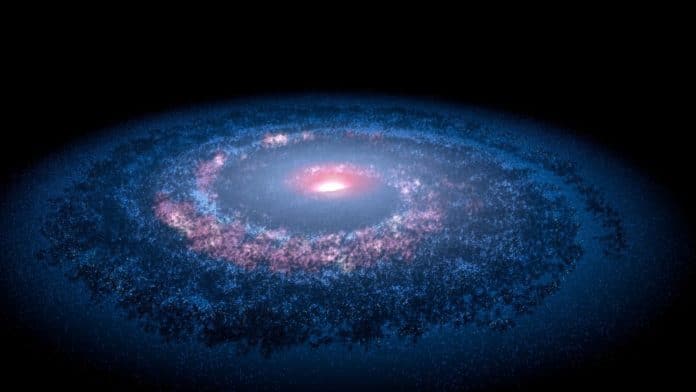The Hubble constant is a unit that describes how fast the Universe is expanding. Discrepancies in the Hubble constant have vexed astronomers for years. The challenge is to do so without ruining the agreement between standard model predictions and other cosmological phenomena, such as the cosmic microwave background.
A team of scientists, including Francis-Yan Cyr-Racine, assistant professor in the Department of Physics and Astronomy at The University of New Mexico, Fei Ge, and Lloyd Knox at the University of California, Davis, wonders whether such a cosmological scenario exists.
They have discovered a previously unnoticed mathematical property of cosmological models that could allow for a faster expansion rate while hardly changing the most precisely tested other predictions of the standard cosmological model. They found that a uniform scaling of the gravitational free-fall rates and photon-electron scattering rate leaves most dimensionless cosmological observables nearly invariant.
Scientists noted, “Basically, we point out that many of the observations we do in cosmology have an inherent symmetry under rescaling the Universe as a whole. This might explain why there appears to be a discrepancy between different measurements of the Universe’s expansion rate.”
The findings could lead to reconciling cosmic microwave background and large-scale structure observations with high values of the Hubble constant: Find a cosmological model in which the scaling transformation can be realized without violating any measurements of quantities not protected by symmetry.
Plus, it could resolve what has proved to be a challenging problem.
Scientists are driven to an exciting conclusion if the Universe is somehow leveraging this symmetry: that there exists a mirror universe that is remarkably identical to ours but unseen to us except through gravitational impact on our world. Such a “mirror world” dark sector would allow for effective scaling of gravitational free-fall rates while maintaining the precise mean photon density now reported.
In simple words, an unseen ‘mirror world’ of particles that interacts with our world only via gravity might be the key to solving a major puzzle- the Hubble constant problem.
Cyr-Racine said, “In practice, this scaling symmetry could only be realized by including a mirror world in the model — a parallel universe with new particles that are all copies of known particles. The mirror world idea first arose in the 1990s but has not previously been recognized as a potential solution to the Hubble constant problem.”
“This might seem crazy at face value, but such mirror worlds have a large physics literature in a completely different context since they can help solve an important problem in particle physics. Our work allows us to link, for the first time, this large literature to an important problem in cosmology.”
Journal Reference:
- Francis-Yan Cyr-Racine, Fei Ge, Lloyd Knox. Symmetry of Cosmological Observables, a Mirror World Dark Sector, and the Hubble Constant. Physical Review Letters, 2022; 128 (20) DOI: 10.1103/PhysRevLett.128.201301
